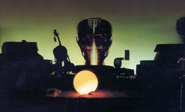Portrait of a recording studio - A look at Vangelis’ Nemo Studios
Private recording studios
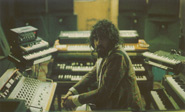
By the late 1960s, studio recording equipment had reached a new level of maturity. The latest technological developments meant that state-of the-art multitrack tape recorders, mixing desks, noise-reduction equipment and a multitude of audio outboard equipment transformed the professional recording studio. This ultimately lead to an increase in the audio sound quality of the recordings and opened up a host of new possibilities for sound producers, who were then able to obtain production techniques previously unimaginable.
However, with this vast array of equipment, it also meant that, proportionally, the recording of compositions took longer to complete, both at the production and mixing stages. Much of the time was spent either editing or at the mixing desk rather than recording the music.
The advantages of owning a private recording studio were apparent. It enabled total creative freedom for musicians to work on a number of simultaneous projects more efficiently, and it gave them time to perform musical experiments before albums were submitted to the record company. Another advantage was that it avoided booking commercial studio time, which removed the burden of moving heavy instruments from one studio to another.
Since the operational costs alone would have been prohibitive for most musicians’ budgets during the mid-1970s, only the most capable or entrepreneur-minded musicians ventured into establishing their own private recording studios. Vangelis’ own music laboratory, Nemo Studios, was such a studio, and it was established, in London, in 1975. For a time period spanning 13 years, Nemo Studios witnessed the launch of Vangelis’ music career on the international scene, and it was the birthplace of several albums and film scores that earned Vangelis critical praise and popular acclaim.
Moving into Nemo Studios, 1975
Before Vangelis obtained the premises at Hampden Gurney Street, the area was previously used by a commercial photographic studio, which utilised the location to build large sets for advertising films and fashion catalogues. However, Vangelis was unable to use the area straight away, because it needed a number of structural changes, so construction workers were brought in to turn the large photographic studio into an area suitable for a recording studio.
In keeping with conventional studio practices, the premises were divided into two areas. One section, which used to be a large kitchen combined with a darkroom, was made into the studio’s control room, and was designated to housing the recording equipment and mixing desk. The other, larger, section was transformed into the live room, and it contained a removable wooden stage and a cyclorama. Both these items were retained from the photographic studio in case they could be used when performing live music.
Nemo’s first recording equipment
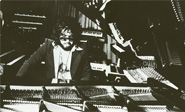
The first recording equipment at Nemo Studios included a customised 24-channel mixing desk, made by Automated Process, Inc., and a customised tape recorder based on the Scully 280 model that allowed recording in 2, 4, 8, 16 and 24 tracks. The customised Scully had three tape transports, but it was usually configured so that simultaneous recordings of 16 multitrack and two 2-track tapes were allowed, each using a dedicated tape transport. Both the API mixing desk and Scully tape machine were purchased second-hand from ‘Command Studios’, a well-known commercial recording facility based near London’s Green Park, where Vangelis had worked before moving to Nemo Studios.
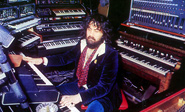
The dynamic nature of Vangelis’ compositions often stretched the limits of the recording equipment, and during the first year there was an ongoing technical problem with the somewhat noisy Scully multitrack tape machine. An example of this is when Vangelis’ music goes from a very quiet piano solo to a sudden full-synthesised orchestra, or vice versa. The dynamics posed challenging problems with the Scully tape recorder, making it difficult to bring out the solo parts in the mix. So when the crescendo died out, it left behind 16 tracks of hiss.
Nemo’s choice for noise reduction
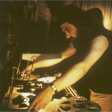
To remedy this problem, it was found that the dbx Type-I noise-reduction unit was helpful. So a 16-channel dbx Model 216 was purchased and applied to the 16-track recordings, to increase the dynamic fidelity and reduce hiss. The dbx was a far less popular noise-reduction system among professional studios compared with Dolby, but Vangelis liked the subtle characteristic sounds it gave to his recordings. The dbx also tidied up the sound, as well as offering a wider dynamic compression than Dolby. dbx noise reduction was first used on multitrack tapes for ‘Albedo 0.39’, and it was used for almost all of Vangelis’ subsequent works. On the other hand, Dolby A-Type noise reduction was used for encoding the final master 2-track recordings on the Scully.
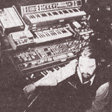
For audio monitoring in the control room, four Tannoy HPD (high-performance dual-line) monitors, which were built by Lockwood Monitors, were put into professional cabinets. The control room was covered with thick carpets and heavy curtains, which absorbed a lot of the volume. Typically, the monitors would be set to moderately loud, but not at a deafening volume, and not for long periods of time. This was so they did not overdrive the monitors. During the final mixing, another audio check could be patched onto small speakers, which were placed on the mixing desk. This step helped to verify the final mix on the smaller speakers.
The live room’ windows were blocked up and the walls and ceilings were painted black. Curtains were hung on all walls. Initially, there were issues with standing waves in the studio. This was not too detrimental to the sound environment inside the studio, but audio rumble affected the neighbouring buildings, which was a particular problem when working late hours at night. The studio’s roof was thin and acted like a huge wooden loudspeaker, which resonated at low bass frequencies. The problem was fixed by adding mass to the ceiling and concrete paving slabs on the roof.
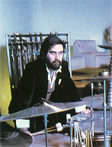
The wooden stage in the live room was surrounded by a three-sided cyclorama. The stage was useful for recording delicate instruments, such as the Asian harp and the guitar, especially when capturing finger movements was integral to the instrument’s sound. Other musical experiments took advantage of the natural acoustics of the building. For example, the well of the stairway leading to the studio’s entrance provided a natural echo for percussion work.
The control room and live room were divided by a partial brick wall, which incorporated a fireplace. A removable glass window was added to completely seal off the access between the two rooms. This arrangement prevented sound leakage when monitoring the audio in the control room. A talkback function was added to allow the performer and the studio engineer to communicate through the glass window. The window was removable, and, if needed, it could be taken out to reopen the spaces between the two rooms.
At the end of the control room stood a sloping wall. The sloping wall was detrimental for recording live work, as it created acoustic problems. Initially, soundproof consultants advised Vangelis to brick up the wall, to make it straight, but that idea was dismissed in favour of retaining aesthetics and keeping the desperately needed space in the control room. In subsequent years, the wall was used to display Vangelis’ disc awards, until the entire wall surface was virtually covered up.
The CS-80 synthesiser
One of the most recognisable instruments in Vangelis’ music is the Yamaha CS-80 analogue synthesiser. Vangelis first spotted the Yamaha CS-80 at a music fair show in London in 1977, where upon he decided to try one out. It was the first polyphonic synthesiser with true performance features, such as after-touch and velocity-sensitive capabilities, and both of these features appealed to Vangelis.
At this time the CS-80 had not been officially introduced to the UK market, and there was already a six month waiting list for the instrument. Vangelis managed to get one on loan for a couple of weeks before deciding whether he wanted to buy one or not. He used the borrowed CS-80 to record the album ‘Spiral’ and the instrument was featured on the majority of his compositions onwards.
To avoid the six month waiting list, Vangelis’ first CS-80 synthesiser was purchased from Japan and train-ferried all the way across Russia to the UK. When the CS-80 first arrived in London it needed the usual internal circuit alterations, so that its voltage was compatible with the UK’s.
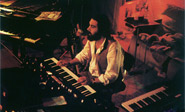
When Vangelis got his first great analogue synthesiser he realised it could produce sounds at frequencies below human audible levels, with its sliding pitch ribbon controller. Such sub-sonic audio levels often stretched the limits of the mixing console. Initially the cones of the Tannoy HPD monitors got damaged and had to be replaced a number of times.
Recording equipment upgrade, 1978
In the first three years at Nemo Studios, a lot of energy and effort was spent on maintaining the recording equipment. Vangelis’ busy working schedule gave little opportunity to make drastic improvements, and he was increasingly being limited by the old and outdated recording equipment. However, by 1978, Vangelis had a chance to take time out from his busy projects, so he decided to upgrade the recording equipment and mixing desk.
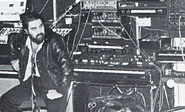
The first problem to be tackled was the tape machine. The Scully tape machine had its limitations, particularly when it was interfaced with dbx noise reduction for multitrack tapes. The dbx required a flat frequency response, and this was a priority when choosing a new multitrack tape machine. Vangelis also needed a machine which could provide the much needed Sync Master mode. The Lyrec TR-532 tape machine was acquired after it was found to meet perfectly with the required specification. The Lyrec tape machine boasted eight additional tracks over the old Scully, giving it a total of 24 tracks. It also provided a host of new features, which included Vari-Speed , Track Solo, Spot Erase and the convenient Auto-Locate, which would memorise up to 16 positions on the tape, plus two working positions.
For this upgrade, a further 8-channel dbx-158 unit was purchased and put next to the existing 16-channel dbx unit. This meant that all of the 24 tracks from the new Lyrec TR-532 multitrack tape recorder were processed with dbx noise reduction. It was from this point on that all of the subsequent works at Nemo Studios were recorded on the Lyrec TR-532 tape machine, and the dbx Type-I noise reduction was almost always used.
In conjunction with the new multitrack tape recorder, two new master tape machines were acquired for putting the final mix-down recording onto quarter-inch tape, these were two Ampex ATR-100s. The second ATR-100 was useful for doing editing work. The two ATR-100 tape machines were equipped with Dolby A-Type noise reduction, as this offered better noise reduction on final stereo recordings, although, in principle, the ATR-100 was a far higher specification compared with the Scully, as it was able to load the tape to a higher level, and therefore could be used without Dolby A-Type noise reduction.
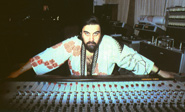
Next to this equipment upgrade, Vangelis also replaced the outdated API mixing desk with a 36-channel Quad/Eight Pacifica mixing desk. The Pacifica was an in-line mixer, as opposed to the split-mixer of the previous desk. This resulted in a more compact design with almost double the channel capacity. In addition to the 36 channels, the Quad/Eight Pacifica had four auxiliary channels, and these were used for sending or receiving echo. The new mixer also had a patch bay for configuring the route of the signal to and from the tape recorders and the outboard equipment.
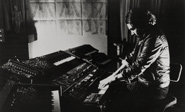
The new recording upgrades Vangelis made at Nemo Studios in 1978 marked a turning point in the studio’s audio fidelity. They did more than just add to the depth and warmth of Vangelis’ sound. They also allowed him to explore new sonic landscapes, which had been technically challenging with the older recording equipment. The first album to take advantage of the new equipment was ‘China’, and its symphonic arrangements clearly benefited from the upgrade.
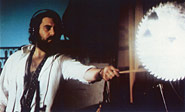
As time went by, the justification for retaining the glass window as a means to reduce audio leakage between the two rooms subsided, as Vangelis’ music relied more on synthesisers, and these instruments were directly injected into the mixing desk. The glass window was permanently removed in 1979 and only put back on the rare occasions when guest producers used Vangelis’ studio for recording singers.
In the 1970s, analogue synthesisers used the principle of voltage-control as a means of communicating the desired pitch between synthesisers and other external devices, such as sequencers. The desired pitch was determined by generating a certain amount of voltage, which could be triggered by pressing a key on the keyboard or the voltage output of a sequencer’s control knob. At the time, analogue sequencers were quite primitive, and they only allowed monophonic sequences and patterns which, in most cases, were no longer than 16 notes. At that time, different manufactures used different schemes on how to map voltages to pitch values. Each manufacturer developed and promoted sequencers for their own synthesisers, although, in many cases, different machines were compatible.
Voltage-control technology
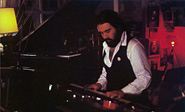
As more synthesisers and sequencers were acquired and brought into Nemo Studios, several of them were linked together by using the principles of voltage control. A flexible voltage-control system was developed at Nemo Studios for live sequencer work, and it was extended to include drum machines, filters and more synthesisers, so that they could all run together and in sync . The system was intuitive to use, as it allowed Vangelis to focus his energy on the improvisational aspect, enabling him to transpose and edit the sequencers on the fly when performing his music, with all the connected synthesisers and sequencers keeping in time and following Vangelis’ musical direction. This system was a natural progression, going back to the way Vangelis had previously worked with his synthesisers and drum machines. It freed him from the constraints of lengthy programming and enabled him to produce a music scene which was instantly responsive and intuitively playable.
The voltage-control sequencer set-up was useful for improvisational work. However, this set-up was soon extended to allow a sequence to be rerun or a new sequencer line to be added on top of existing ones at a later convenient date. This was achieved after the development of a technique (at Nemo Studios) which enabled a ‘gate’ signal to be recorded onto tape, then, during playback, the trigger from the tape was used to let the sequencers and drum machines step in time. This meant that the final specification of the sequencers could - in theory - be modified or altered at a later date should this be necessary. Triggering sequencers and drum machines from tape provided greater means for creating complex polyphonic sequencers and aural textures which were not possible with the hardware available at that point in time. Two examples of these were demonstrated on the sonic introduction on the composition ‘The Long March’, from the album ‘China’, and the repeating snare drum on ‘Chariots of Fire’, where the latter was the last overdub added to the track.
Into a new decade, the 1980s
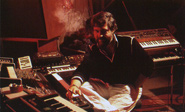
In 1980, the analogue echo and reverb devices, like the Binson Echorec, RE-201 Space Echo and AKG BX-20, were set aside when Nemo Studios received the Lexicon 224. It was the first digital-based reverb unit, which had a markedly cleaner sound than the older reverb units. Once the Lexicon arrived at the studio, the simulation of ambiences from the natural acoustics of the studio was also given up in favour of using the new digital reverb devices.
It was not just audio outboard equipment that was going digital at this stage, but instruments took advantage of the digital revolution as well. For example, sequencer controllers such as Roland System-100 and System-700 machines were joined by the Roland CSQ-600 and Roland CSQ-100. The new CSQ sequencers were microcomputer-based machines and had the facility to program a greater number of steps into their memory.
Around the same time, the monitors in the control room were upgraded with two Tannoy Dreadnought monitors. The new Dreadnought monitors replaced the four Tannoy HPD monitors. For a period of six months before upgrading to the new monitors, the studio tested several monitors from JBL and Tannoy before settling on the Dreadnought. Each Dreadnought was fitted with cones for high, medium and low range, and each range was independently powered by a dedicated BGW 750B amplifier.
Before deciding whether to purchase an expensive piece of hardware - as was the case with his first Yamaha CS-80 or the Tannoy Dreadnought monitors - Vangelis would test the equipment or a new synthesiser for a trial period. A music shop ‘showroom’ in London would get the latest equipment, and this showroom was the main supplier of Vangelis’ new gadgets. Vangelis would either be invited for a private showing at the showroom, or a representative would bring new synthesisers to Nemo Studios for a demonstration. If a particular piece of equipment was of interest to the studio, a demonstration would be arranged at Nemo Studios and, if Vangelis approved, it would be purchased.
Vangelis bought all his equipment and synthesisers and did not take on sponsorships offered by any synthesiser or audio-equipment manufacturer.
From analogue to digital
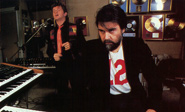
In the early 1980s, the slow advent of digital and computer-based hardware introduced another type of electronically powered keyboard, known as the sampler. The sampler added a new sense of realism to the palettes of electronic sounds, enabling a single musical note, or any sound, to be captured and then played back in different notes from the touch of a keyboard. At Nemo Studios, the first sampler was E-mu’s Emulator keyboard. Originally, it was acquired as a potential replacement for the Linn LM-1 drum machine, with the idea that Vangelis could make drum patterns and sequencers using his own drum samples, and that it could also store samples internally, along with sequences and chains of sequences. However, Vangelis could not get the Emulator to react quickly enough, and so it was not used that much for drum sequences. Instead, he used the Emulator as a percussion sampler, which empowered him with more sounds at his fingertips.
Vocal recordings
Vangelis collaborated with vocalist Jon Anderson on several song-based albums. When they were writing or recording basic tracks, Vangelis would play the melody and set-up the musical scene, and Jon would stand or sit next to Vangelis and ‘scat’ sing, laying down a ‘guide’ vocal, as means of putting down musical ideas. Because of the layout of the studio, it was often preferable to record vocals in the control room, Vangelis and Jon could see each other and communicate easily. Once the music for the song was completed, the master vocals were usually recorded in the live room, with the volume of the Tannoy Dreadnought monitors in the control room turned right down and Jon wearing the headphones.
Sometimes, Vangelis liked to process the vocals via a vocoder, and this was done with the Roland VP-330 VocoderPlus synthesiser. The effect gave the voice a certain floating quality, which became a distinctive part of Vangelis’ works featuring vocalists.
Other acoustic instruments, like the saxophone or the electric guitar, were recorded in the live room, using a process that was similar to recording vocals, by using headphones and turning the volume right down on the monitors. As Nemo Studios was a synthesiser-based studio, its range of microphones were limited, an instrument like a saxophone is normally recorded with a mono microphone, preferably a tube, and occasionally combined with an ambient microphone if the room has interesting acoustics.
Renovation 1983
In late 1983, Nemo Studios underwent a renovation. The renovation was more of an aesthetic remodelling rather than a soundproofing exercise or major upgrade of equipment. The control room was given a facelift with colourful paint, the beige-coloured curtains were replaced with blue ones and cosy, warm lighting was installed. The Steinway & Sons Concert Grand Piano that occupied the corner of the room was removed, which made the control room easier to navigate. The tape machines, dbx noise-reduction units and other audio equipment were relocated from the windowed and curtained wall to the sloping wall right behind Vangelis’ synthesiser set-up.
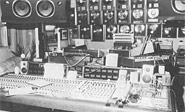
A more crucial transformation took place in the live room, with the permanent removal of the wooden stage. Dispensing with the wooden stage created a roomier space. Much of the orchestral percussion and drums that were scattered throughout the live room were electronically sampled onto floppy disks and then stored behind the cyclorama’s wall and at storage facilities in London, but some percussion instruments were occasionally brought back into the studio, such as the drum kit and timbales, whenever Vangelis needed them. Removal of the moveable stage also enabled Vangelis’ two pianos to be placed at the back of the studio room, his Steinway & Sons Grand Piano and a Bösendorfer Imperial Grand Piano, and both pianos were set up so they were permanently miked to the mixer.
Coinciding with the studio’s renovation was the installation of a new Barco video projector in the live room, and it was positioned so that it projected a video image on the cyclorama’s back wall. The projector was hung from the gantry and was linked to a rack of videotape players situated to the side of the live room. A second synthesiser set-up was conveniently placed near the projector’s screen. This was useful when a film director would come over with video material, as then Vangelis could fire off his ideas instantly during discussions with the director. The projector was also useful when Vangelis needed to review a film before starting work or when viewing the final film with his score to simulate the cinema experience. However, Vangelis did not compose music to film by viewing the scene on the projector screen; instead, he preferred to compose in the control room by using a small television to view the picture. Occasionally, another television was brought in and placed near the control room, so both Vangelis and the studio engineer could each face a screen comfortably and view the picture from wherever they were seated, and Vangelis could then also use a remote to control the video playback himself if he wished.
Working for film
When working for a major film, all video was supplied to Nemo Studios on three-quarter-inch videotape or, at times, even on VHS videotape. The video streams may have been provided with a ‘time-code readout’, but usually no other information was embedded, such as SMPTE code or video/audio lock-up information, as these technologies were still in their formative years as far as London-based studios were concerned, apart from a few high-end studios such as Abbey Road, Air and CTS.
Synchronisation between music and video playback was all manually done by hand and relied on pressing the play and record buttons on the video player and the tape recorder at the same time. A loose type of synchronisation could be achieved by aligning a video frame with a line drawn on the multitrack tape, or Vangelis would record a four count on the piano, or the lead instrument, identifying a point in the picture to match that to, and that would be the starting point.
All recording, overdubs and playbacks started with that four count. Later on, at mixing stage, the four count would also be included in the mix on the quarter-inch tape. When the tape was taken to the sound stage, the count was used as a cue to the music editor to start the tape and then dub the music into film.
Ideally, Nemo Studios’ only request for working on film was to be given the final cut of the scene before Vangelis would start composing any music.
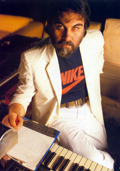
Tape storage
Reels of magnetic tapes of recording projects were labelled and stored in Nemo Studios’ tape storage room. The tape storage room contained Vangelis’ compositions, on magnetic tapes, from recent projects.
The very first tape storage space was the small stow room located in the corner of the live room next to the fireplace. However, this room proved to be handy for storing other items, like percussion and cables, and a couple of years later, a dedicated room rented in the building on the floor below was designated as the storeroom for all of the multitrack and 2-track tapes. The tapes were labelled and identified by date, such as 820221 for 21 February 1982, and they were filed according to number. Sometimes a title or some identifying code, like V-BR-12, would be added to the label when an appropriate name or code was designated.
However, in 1980, the tape storage room was moved for a third time, and this new space was conveniently located on the same floor as the studio. It was situated in the hallway just outside the studio and accessed via a narrow flight of wooden stairs. This new tape storage room could hold around 150 to 200 tapes of current recording projects, again both quarter-inch and 2-inch tapes. The tapes remained in storage until their designated projects were completed and Vangelis no longer needed them. At this point, the tapes would be labelled, boxed and transported to professional tape storage centres.
For active recording projects, multitrack tapes would normally be kept on a shelf in the control room. By the early 1980s, the demand for Vangelis’ work intensified, as his reputation was among the most respected figures in music. As Vangelis never planned ahead, and nothing was fixed in terms of working hours or what project he would tackle on any given day (as he preferred to let his inspiration and mood dictate the workflow for that day), he would skip from working on a major film project one day to work on another music project next and then revert back to film the day after. This resulted in a chaotic scattering of tapes around the studio’s floor. Tapes got piled up against the wall in the control room, in double and triple lines, but they were grouped together according to project, for easy access.
This routine proved more difficult when working on a film soundtrack, keeping track of all the little scenes, as well as out-takes, edits and masters on a film project, became a drawback when trying identify a piece of music by the film’s script. This resulted in undesirable delays for Vangelis when he requested a particular scene to be worked on. Instead, Vangelis had to put his creativity on hold, as he would have to wait for the proper tape to be identified by the studio’s engineer, who would load the correct tape into the machine and cue the tape to the corresponding position in the film’s scene. This made tape access and storage difficult and, as a result, lead to the abundance of tapes in the control room.
When this practice proved to be inefficient, a studio logbook was created, and it was used to catalogue and identify tapes beyond just title names and simple codes. Entries included the date and time of the original recording, an identifier code, the project’s name and additional helpful notes that would describe the film’s scene in more detail. Tape-box labels were also custom-made for Nemo Studios, and these allowed more details to be added - this information was similar to the information other commercial studio’s at the time would have recorded. This helped to make it easier, with the proper identification number, to retrieve the correct tape and begin work on a piece of music for a particular film scene.
Patching sounds on the mixing desk
Instruments on the Quad/Eight Pacifica mixing desk were typically patched at certain channels. It was a common practice at any recording studio at the time, when working on any album, to keep the channel order listing reasonably similar, to reduce time when changing over songs, especially when working on one album for a length of time and staying at the same studio for a while.
When recording on the multitrack tape machine, certain sounds, when used in the backing track or initial recordings, were always recorded on the same track numbers, and therefore the sounds would always return to the same place on the Pacifica mixing desk. Vangelis used to prefer certain overdubs to go onto certain tracks as well, as this made it easier at a later stage; they too would appear in their designated spots on the mixing desk. This was also helpful when mixing, as Vangelis did not have to go scrabbling around looking for the CS-80, piano sound, strings or cymbals, as they were always in the same place. When working on films or albums, it was incredibly useful, as it meant that when switching from scene to scene, or song to song, there would not be time wasted in repositioning the equaliser, panning, effects or levels, and it provided a form of human automation.
Mixing-down
Because Vangelis’ compositions tended to be lengthy, and to avoid the risk of tape running over, it was sometimes a practice to run the tape machine at half the speed, at 15 inch per second instead of 30 inch per second. This resulted in reduced signal-to-noise ratio and made the use of the Dolby A-Type noise reduction a necessity for the stereo mix-down.
On the other hand, dbx noise reduction remained in use for the Lyrec TR-532 multitrack tape machine, but it proved to be a tricky system to use. As Nemo Studios was the only professional recording studio in London with dbx, repairs were difficult to arrange. It also meant that if Vangelis ever needed to go to another studio in Paris, New York or Los Angeles, logistics became a problem, as there were no other studios that used the dbx system, as they all used Dolby systems. That limited flexibility when working on the compositions recorded at external studios, as the recordings would be later brought back and transferred to Nemo Studios.
When the dbx system finally broke down, previous work recorded on 24-track 2-inch tape could only be salvaged by carrying out costly repairs to the dbx for proper playback or finding rare and expensive replacements. The first dbx units at Nemo Studios were eventually upgraded in the mid-1980s, and a new set of 12 dbx 180 dual-channel Type-I noise-reduction units. The new dbx units again covered all of the 24 tracks of the Lyrec TR-532 multitrack tape machine.
Once the 24-track tapes were mixed down and transferred to quarter-inch analogue tape, all copies of the music were made onto cassettes for Vangelis, and any mastering of albums or transferring of film music was done outside of Nemo Studios at a mastering facility, from a 2-track quarter-inch tape.
When making an album for a vinyl record, the final step before proceeding on making a master involved producing a test acetate, to assess whether the music has been successfully transferred. As the dynamic range of Vangelis’ music often stretched the limits of the available equipment and the physical medium of the vinyl record, a lot of effort was put into mastering, and it may have taken a few days to arrive at the final results.
If the initial acetate test indicated further work was needed, Vangelis may have gone back to Nemo Studios to apply further equalisation and various tweaks, including adjusting levels. This would be then put on a second production master tape using the two ATR-100 tape machines - this was, in effect, a second generation down from the original mix - and the mastering engineer at the mastering facility would try again. Once the results were satisfactory, the master acetate was then cut, using the approved settings, and finally submitted it to the vinyl pressing plant, where vinyl records are made.
Triggering from a gate signal
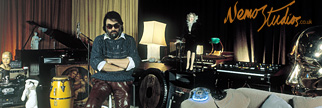
In the late 1970s, Nemo Studios successfully found an inventive way to lock a ‘gate’ signal into tape as means to let analogue sequencers and drum machines to step in sync. This technique was developed at a time when there was no way of locking code on tape and it allowed to create complex polyphonic and drum sequences when overdubbing, thanks to voltage-control technology. However, Vangelis did not use this technique in later years in 1980s, as it became problematic, especially when changing tempo or using the ‘Vari-Speed’ function on the multitrack tape recorder.
As studio equipment in the industry developed other more straightforward techniques appeared for putting a gate into tape, such as ‘pre-striping’ a tape with code, LINN or otherwise. However, it was never used at Nemo Studios, as it required each tape to roll and record 25 minutes or so worth of codes, before the events could be locked, and Vangelis would not have the patience to wait to prime a tape before composing music.
The arrival of MIDI control
In the mid-1980s, the digital and computerised age started to dominate electronic equipment more appreciably than ever before. The advent of computer-based hardware lead to more reliable hardware and new means for sound generations like microprocessor-controlled sequencers, multitimbral FM synthesis and digital sampling of acoustic instruments. However, one of the most significant developments on the synthesiser was the introduction of MIDI to allow interconnecting synthesisers and musical instruments, as opposed to using voltage-control technology to enable communication between synthesisers.
While MIDI allowed easier interfacing of new synthesisers and interchangeability between instruments of different brands, during MIDI’s early introduction to Nemo Studios, it was mainly used to chain several keyboards to a master keyboard, which also included a MIDIfied grand piano among Vangelis’ set-up. The distance between the MIDI grand piano and the control room was considerable enough to result in a delay in the notes, so a second synthesiser was installed in the live room. The use of MIDI was again another example where Vangelis harnessed new technology to enable the creation of rich symphonic sounds, with the least amount of disturbance, when an idea or inspiration arrived.
When it came to creating sequencers, the early MIDI devices were unfriendly, from a performer’s point of view, and initial models were implemented as playback machines rather than a performance instrument that a musician can play and interact with in real time. When it came to sequencer work, voltage-control was very much favoured over MIDI, as it proved to be more playable and intuitive to use.
Composing and performing in real time
Vangelis utilised MIDI to layer sounds and control the performance with volume foot pedals. MIDI routers were custom-built for Nemo Studios for that purpose, so Vangelis could instantly assign a couple of his synthesisers as two master MIDI keyboards, with each master synthesiser assigned to three MIDI synthesisers. It was one of the very early prototypes of its kind at the time. With this set-up Vangelis could layer textures and, by using the synthesisers’ foot pedals, he could bring a symphonic sound into play. Everything was composed and recorded live, and whenever he introduced a sound on the instruments that was how it remained on tape.
There was no striping of tape with SMPTE code for later synchronisation and no re-triggering of synthesiser sounds from tape. The same principle was also held for drum machines - such the Linn Drum - and sequencers in general, which were never re-triggered, and there was never a time-code used for drums or sequencers. Vangelis would program a quick drum loop and, while playing the keyboard parts live, reach over and ‘play’ the drum machine as well. As far as sequencing itself, there was no MIDI sequencing, everything remained voltage-control based and was performed live to tape, with possibly one or more subsequent overdubs to finish the track.
The mid 1980s
For the first decade at Nemo Studios there was no air conditioning in the control room. However, as Vangelis’ work schedule would not start before mid afternoon, or the evening at times, and temperatures did not pose problems to the equipment or cause discomfort during working hours, it was not necessary. If there was an exceptionally hot summer’s day in London, electric fans were brought in and the large window in the control room was opened to provide enough cool air. However, as temperature levels became uncomfortable for those who were more accustomed to working at cooler temperatures in commercial recording studios, and to be more accommodating, a number of portable air-conditioning units, that were approximately 4 x 3 x 2 feet, were brought into Nemo Studios’ control room. The units had to be placed near the windows so the ‘exhaust’ fumes could escape, and this allowed ice-cold air to be pumped inside the control room. During the winter, portable electric heaters were used and there was a fireplace in the live room, which was decorative as well as practical.
From 1984 onwards, Vangelis spent some time abroad, and to accommodate his synthesiser set-up, he acquired two Akai MG1212 12-track recorders, which came with built-in mixer boards. The two recorders operated with cassette tapes and could be linked in together to provide a total of 24 tracks. This portable studio allowed Vangelis to compose music at his hotel suite, and later the compositions could be transferred to traditional 2-inch, 24-track tapes.
While the digital reverb Lexicon 224 was later joined by its successor models, such as the Lexicon 224X and 480L, and those by other brands, such as Quantec QRS and Yamaha models such as Rev-7, SPX-90 and Rev-5, Vangelis preferred his trusty Lexicon 224 reverb unit, even though it was a bit noisy in comparison. Other equipment audio gear included the Dytronics CS-5 Tri-Stereo Chorus and the Dytronics FS-1 Cyclosonic Panner.
Lack of soundproofed live room
Initially, when Nemo was constructed, there were plans to install a glass wall between the control room and the live room, for recording live and vocal work, to limit audio leakage. But this plan was not practical for the studio, as it limited the movement between the two rooms and Vangelis also liked to be able to interact with the vocalist when improvising music in the control room. The glass wall was removed during the making of the ‘China’ album. However, the open space between the two rooms was inconvenient, as audio leakage did occur when recording live work. During the making of the ‘Mask’ album, a 21-piece choir from the English Chamber Choir sang their vocal parts in the live room, each was provided with a microphone and a set of headphones. Their headphones were turned down very quietly and several microphones were hired for this purpose, so that there would be enough ‘matching sets’ of good vocal microphones. The performance had to be monitored in the control room at very low levels to avoid audio leakage. The lack of a fully soundproofed studio also meant that recordings had to be carefully monitored to ensure that outside noises, such as police sirens or a telephone ringing, were not included.
The saga of Nemo Studios
By the late 1980s, developments in the professional studio took great steps forward, from easily connected synthesisers to miniaturised sound-generation modules, next to more compact multitrack recorders and microprocessor-assisted mixing desks - a few of the many innovations that resulted in new paradigms in how music is composed and recorded. The convenience offered by these new innovations meant more autonomous automation, lower recording equipment costs and the abundance of sounds that could be selected by navigating menus displayed on sound modules, pushing buttons on synthesisers or using a mouse on a computer screen. All of these resulted in destroying the notion of maintaining a large recording studio for a single artist, and the birth of the home recording studio was unleashed.
In 1987, as the leasing of the space occupied by Nemo Studios on the top floor of the Hampden Gurney building was due for renewal, and after having considered staying longer at his London studio, sadly, Nemo Studios was to reach the end of its long and fruitful journey. What was originally planned to be a short break from London became an extended break from recording studios, and Vangelis travelled the world with his portable set-up. He would not own a proper recording studio of his own until a few years later.
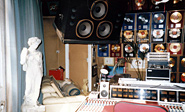
Vangelis regarded his Nemo studio his own science laboratory, using his synthesisers and electronic equipment as basic scientific tools. The invention of the synthesiser, in Vangelis’ view, was one of the greatest technological achievements of the century. Vangelis saw that a musician could use a synthesiser in a similar manner as a scientist could use a telescope or a microscope to probe the universe, seeking to discover one of the many fundamental laws of nature. Similarly, Vangelis, through his music, used synthesisers to communicate with nature and to rediscover music that had existed since the beginning of time, longing to be rediscovered and to be remembered. He approached music as a scientific subject, and for Vangelis it was never a means of entertainment or making money.
While recording equipment has taken many different steps and changes, Vangelis reflected on his particular disappointment with the evolutionary development of the synthesiser as a musical instrument, or, in fact, its regression throughout the years. He reflected how, since the invention of the synthesiser in the 1970s, there had not been one single model that had evolved, in an absolute consistent manner and continuity, to enable musician and synthesiser to develop together. To Vangelis, the subsequent synthesiser designs appeared as if they were made by people who did not appreciate and incorporate the human factor in the designs.
Vangelis maintained that a musician’s natural creativity and their reflexes are much faster than the response times of computers, and creating and performing music with new technology should lead to more spontaneous and instantaneous musical creations. Instead, he observed that in many recording environments musicians would frustratingly play around with interfaces for a piece of music to materialise, and sadly, in some instances, this would result in music that was created by trial and error. This, in Vangelis’ view, was not the way to create honest music.
Vangelis always kept himself abreast of new developments in technology, and in some instances he was ahead of it. In order not to be trapped by the recent design faults in synthesisers, he started to design synthesiser interfaces and technological tools to suit his own style, which evolved around his personal approach for expressing and creating music. It liberated Vangelis from being trapped by the mundane, frustrating designs as dictated by the manufacturers’ models, but at the same time, he was able to utilise the latest advances in sound design, keyboard construction and various other advances. Vangelis’ own designs allowed him to evolve with the technology in a consistent manner.
As Vangelis crafted his own form of sounds at his sound laboratory, he could not wait to see his own music express itself. He needed to hear his work the moment he created it, at the same instant; so that the amount of time it took to make and record a piece took just as long to compose it. When Vangelis would sit in front of his electronic instruments, he knew exactly the sound he wanted to hear at the moment he created his music, and it was always the final sound. To achieve this, Vangelis recalled that, from a young age, he started to combine all aspects of music creation. For Vangelis, there was no separation between the elements of creating music, instead they were combined into one form: from instant access to sounds, the act of composing and performing his composition using multiple synthesisers, to recording his performance to tape - Vangelis was able to achieve this by inventing his own electronic universe. He shaped it and developed it gradually, always seeking to shorten the amount of time from the moment of inspiration to the moment of final performance.
Listening to the music recordings made at Vangelis’ sound laboratory Nemo Studios, you can appreciate the multilayered textures that were mixed from a meagre 24-track tape recorder and using a very limited set of audio outboard equipment. Capturing Vangelis’ performance involved having to overcome analogue tape hiss as a result of his immense dynamic range. The liveliness he was able to exude from the cold machines and the deliverance of his phrasing and expression on every key note, the lushness of his full symphonic sounds; Vangelis made it sound so simple and natural, but with the recording equipment and recording practices, it may have been hard work to make his spontaneous compositions shine through with the technological limitations of the time.
nemostudios.co.uk wishes to thank Keith Spencer-Allen, Raphael Preston, and Jess Sutcliffe for their kind assistance and invaluable contributions towards making this article.
